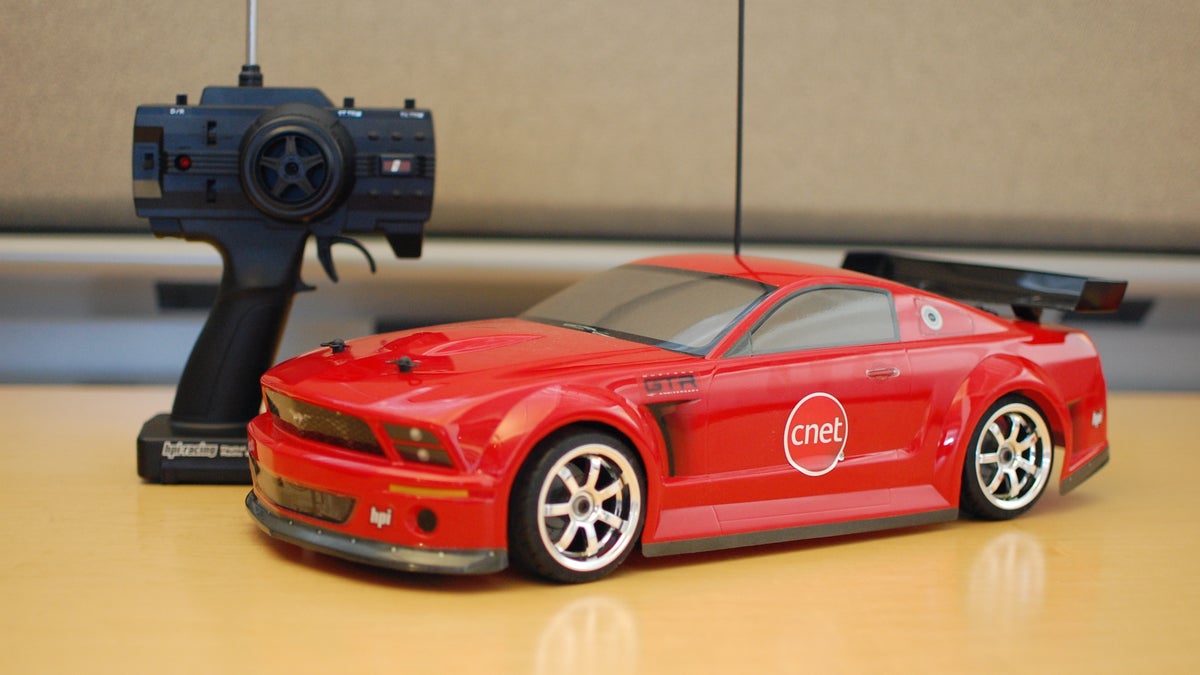HPI Racing provides electric thrills at 1/10th scale
The HPI Racing E10 RTR is a good entry point into the world of R/C cars.

Last month, Ford unveiled it's electric Focus. This month, we've had the pleasure of tooling around with an all electric Mustang and, well, it's small. Actually, it's 1/10th scale small, because the electric car in question is the HPI Racing E10 RTR remote control car.
Okay, so it's a toy, but it's a pretty serious one. The $250-299 cost of entry will be prohibitive to many casual users.
The E10 RTR kit is the preassembled version of HPI's E10 R/C car chassis and accessories--RTR standing for "ready to run"--but there are quite a few user servicable parts. The simplicity of on out-of-the-box kit makes it easy for novices to setup and use. However, the wide array of upgrades and swappable parts makes it a great next step for users who want to get dig into the world of custom R/C.
Power flows from the removable, rechargeable 7.2V 1500mAh NiCd battery pack. THe E10 kit ships with an AC charger that recharges the battery pack in about 6 hours. However, we were only able to get about 30-45 minutes of play from a full charge, so we'd recommend that your first upgrade be either a second battery pack (about $15-20 at online retailers) or a step up to the GT 7.2v 3300mAh NiMH battery ($40 direct from HPI) for double the play time per charge.
From the battery, power flows to into the radio equipment box. Inside the box are the throttle controller, steering servo, power switch, and the radio receiver itself. The receiver features a user swappable AM radio crystal that operates at around 27MHz and matches with a removable crystal unit in the remote control. Users are able to purchase extra crystal sets ($15 direct from HPI) that operate at different frequencies, so that up to six cars and controllers can be used without interference.
From the radio box, energy either flows through the steering servo to turn the front wheels or to the motor, a 27-turn Saturn Performance unit, and out through the transmission (also user servicable with a variety of custom gears, differentials, and driveshafts). The E10 is setup for all-wheel drive operation, sending a 50/50 split of available power to the front and rear axles. At each end of the vehicle is a differential, that allows power to be split from left to right, but it's open design means that torque ends up being sent to the wheel with the most slip. Of course, locked and limited-slip differentials, as well as different gear ratios, are also available as upgrades.
The E10 chassis also features a fully independent, fully sprung suspension. Of course, the springs, wheels, and tires are all upgradable--are you noticing a trend here?
The chassis also features a foam front bumper, for those inevitable crashes, and four adjustable posts onto which the the plastic body shell mounts.
Our HPI E10 RTR kit was shipped with a Ford Mustang GTR shell, reminicent of the 2005 Ford Mustang GTR concept. The shell is made of very thin plastic and features vinyl stickers for the details (windshield, headlights, etc.). Near the back is a removable plastic GT wing. The shell features pass-throughs for the whip antenna and the four mounting posts; and is held in place with four pins.
The remote control that ships with the E10 RTR kit is HPI Racing's TF-1 digital proportional unit. The TF-1 is a three channel unit with a steering knob, trigger controlled throttle, and quite a bit of adjustment available in the form of adjustable steering and throttle trim and reverible steering. The controller is powered by eight AA batteries and features a connection for the user swappable frequency crystal to correspond with the crystal in the E10's radio receiver.
In its out of the box setup, the E10 kit is a ton of fun--and by "ton" we mean "about half an hours' worth." In its default "touring" setup, the R/C car was easy to control as we took it for a spin around the CNET offices. Rain prevented us from taking the electric R/C outside of the garage, but the low ride height makes this kit best suited for smoother surfaces.
Instructions are provided for converting the powertrain configuration to the "drift" layout, which reverses the orientation of the engine and radio box, adjusting the weight distribution for more slide-friendly handling.
Interestingly, half of the fun that the E10 kit provides is the upgrades and tweaking. There are dozens of powertrain, suspension, and chassis upgrades available for users to experiment with (there's even an electronic stability control module available) and about a hundred body shells from which to choose. That doesn't even include the third party accessories and add-ons that have sprung up around the internet.
Which brings us to the only real con that we could find about the E10 RTR kit: price. At an MSRP of $299, this is no simple impulse purchase or child's toy. Being an older kit, you may be able to find the E10 RTR at as much as a 25-percent discount around the net, but it's still a pretty good chunk of change, however you slice it. Additionally, if you get sucked into the world of upgrades, it can quickly become a very expensive habit.

